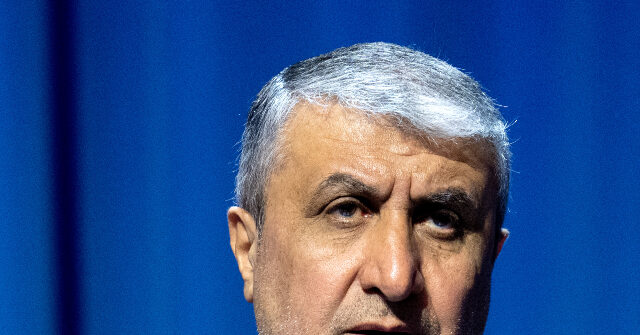Mohammad Eslami, head of the Atomic Energy Organization of Iran (AEOI), said on Tuesday that the regime is already making plans to restore its nuclear industry after heavy airstrikes by Israel and the United States.
“The plan is to prevent interruptions in the process of production and services,” Eslami said.
Iran’s uranium enrichment suffered some rather severe “interruptions” when American B-2 bombers and cruise missiles leveled the primary enrichment sites at Fordow, Natanz, and Isfahan on Saturday night. Secretary of Defense Pete Hegseth said the strikes “devastated the Iranian nuclear program.”
The most difficult of the Iranian sites to attack was the deeply buried facility at Fordow, which lies hundreds of feet beneath difficult mountainous terrain. Satellite photos taken the day after the attack showed several of its tunnel entrances collapsed and a heavy layer of dirt lying over the entire complex.
Damage to the underground facility is far more difficult to assess, for both the Iranian and American militaries. Joint Chiefs of Staff chairman Gen. Dan Caine said the facility was hit with multiple 30,000-pound Massive Ordnance Penetrator (MOP) bombs, the biggest non-nuclear weapon in the U.S. arsenal.
Eslami said on Tuesday that a full assessment of the damage to Fordow and the other facilities has just begun. International Atomic Energy Agency chief Rafael Grossi has demanded access to the sites to conduct an independent damage assessment.
“At this time, no one including the IAEA, is in a position to have fully assessed the underground damage at Fordow,” Grossi told the IAEA board of governors on Monday, although he said “very significant damage is expected to have occurred,” based on satellite photos of the aftermath.
Eslami claimed two weeks ago that Iran has at least one more uranium enrichment site, “fully constructed and located in a secure, invulnerable location.”
“As soon as centrifuge installation and setup are complete, enrichment will begin,” he said.
Eslami made that claim immediately after Iran was censured by the IAEA board of governors for failing to live up to its obligations under the Nuclear Non-Proliferation Treaty (NPT). The IAEA accused Iran of failing to disclose activity at all of its enrichment sites, as required by the treaty.
While some observers suspected the claim of additional secret uranium facilities was bluster designed to make the Iranian people believe the regime’s nuclear program was indestructible, others pointed out that Iran could establish any number of hardened underground facilities without having to disclose their locations to the IAEA. The sites would not be covered by the NPT until uranium refining equipment was installed.
Tehran accused the IAEA of collaborating with Israel to manufacture an excuse for attacking the Iranian nuclear program and threatened to withdraw from the NPT, which it originally signed in 1968. This would suggest that the Iranians plan to become a great deal more secretive about their push for nuclear weapons – and that they were already lying about it.
Iranian officials have claimed all of their near-weapons-grade uranium was removed from the facilities at Fordow, Natanz, and Isfahan before the U.S. airstrikes. An adviser to “Supreme Leader” Ayatollah Ali Khamenei claimed the highly enriched uranium is safe, and “the game is not over.”
Two unnamed Israeli officials told the left-wing New York Times (NYT) on Sunday they believe the Fordow facility has “sustained serious damage” but “has not been completely destroyed.”
The Israeli officials also said Iran may have been able to remove uranium and enrichment equipment from the site, a conclusion partly based on satellite photos that showed sixteen cargo trucks parked near the entrance to the Fordow underground complex shortly before the U.S. airstrike.
Nuclear weapons analysts say that Iran’s expensive and hard-to-move centrifuges are at least as much of a threat as the 900 pounds of 60 percent enriched uranium it had amassed.
Iran invested a great deal of time and money in building up an inventory of advanced centrifuges that can process uranium much faster than the archaic models it started with, thus reducing the “breakout time” needed to take 60 percent uranium the final step to 90 percent weapons-grade purity. If those centrifuges were destroyed or buried at Fordow, it could take years for Iran to replace them.
Sen. Markwayne Mullin (R-OK) of the Senate Armed Services Committee said on Monday that contrary to Iran’s claims, U.S. intelligence does not believe the Iranians were able to relocate their uranium stockpile.
“In fact, we actually believe they stored more of it in Fordo because they believe Fordo was impenetrable. They thought it was a safe place to be,” Mullin said.
“We have the ability to destroy things that people think were undestroyable. And so we think we did a really good job,” he added. “However, if we find out that we didn’t, we will be working with our allies to finish the job or we will finish the job.”



